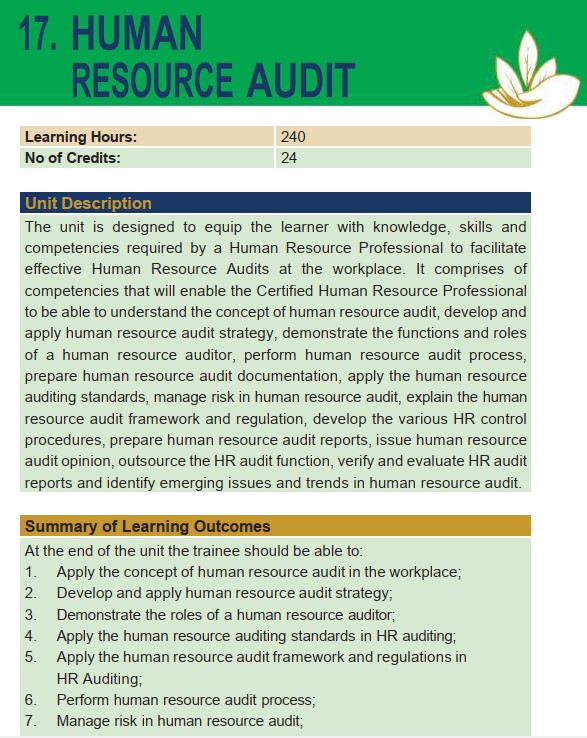
Topics
1. Introduction to Human Resource Audit
1.1 Definition of human resource audit
1.2 Nature of human resource audit
1.3 Evolution of human resource audit
1.4 Features of human resource auditing
1.5 Objectives of human resource auditing
1.6 The scope of human resource audits
1.7 Challenges in human resource audit
2. Human Resource Audit Strategy
2.1 Methods/approaches to human resource audit
2.2 Human resource auditing principles
2.3 Human resource auditing techniques
2.4 Types of human resource audits
2.5 Human resource audit protocols
2.6 Human resource audit value proposition
3. Human Resource Auditor
3.1 Responsibilities of a human resource auditor
3.2 Qualifications of a human resource auditor
3.3 Qualities of a human resource auditor
3.4 Internal human resource audit assignments
3.5 Appointment of first auditors
3.6 Appointment of the subsequent auditor
3.7 Disqualification of human resource auditor
4. Human Resource Auditing Standards
4.1 Objectives of human resource auditing standards
4.2 Principles of human resource auditing standards
4.3 Types of human resource auditing standards
4.4 Benefits of human resource auditing standards
4.5 Challenges human resource auditing standards
5. Human Resource Audit Framework and Regulation
5.1 Audit framework and regulation
5.2 Concepts of accountability, stewardship and agency
5.3 Objectives of audit framework and regulation
5.4 Elements of audit framework and regulation
5.5 Types framework and regulation
5.6 Fraud, laws and regulations
5.7 The concept of true and fair presentation
5.8 Responsibilities of human resource auditors in prevention and detection of fraud and error
5.9 External audit and other review engagements
5.10 Requirements of professional ethics
6. Human Resource Audit Process
6.1 Determining the scope and type of audit
6.2 Human resource audit planning
6.3 Preparation of human resource audit documentation
6.4 Human resource audit data collection and sampling
6.5 HR audit evidence, verification and evaluation
6.6 Analysing & interpreting the audit data
6.7 Benchmarking of findings
6.8 Report preparation and feedback giving
6.9 Human resource audit reporting
6.10 Human resource audit opinion and subsequent events
6.11 Building an environment for continuous improvement
7. Human Resource Audit Risk Management
7.1 Introduction to human resource audit risk management
7.2 Objectives human resource risk management
7.3 Principles of human resource audit resource management
7.4 Types of human resource audit risks
7.5 Assessing human resource audit risks
7.6 Risk assessment process
7.7 The risk register
8. HR Control Procedures
8.1 Introduction to HR control procedures
8.2 Objectives and importance of HR procedures
8.3 Types of HR internal controls
8.4 Components of internal control
8.5 Benefits of internal control
8.6 Evaluation of internal controls
8.7 Communication on internal control
8.8 Test checking
8.9 Duties of a human resource auditor in preventing fraud
8.10 Limitations of internal control
9. Outsourcing HR Audit Function
9.1 The concept of HR audit outsourcing
9.2 Advantages of outsourcing
9.3 Factors to consider when outsourcing
9.4 Challenges of outsourcing
10 Emerging Issues and Trends in Human Resource Audit and their ICT Applications
10.1 Emerging trends and innovations
10.2 Agile audit
10.3 Human resource audit in an automated environment
10.4 Challenges of computerised audit
10.5 Auditing the risk of disruptive technologies
10.6 The changing nature of the workforce
10.7 Automation and cognitive intelligence
10.8 Challenges of emerging trends and issues
10.9 Overcoming the emerging trends and issues
